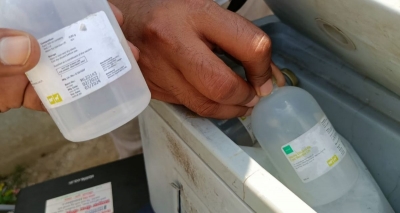Shahjahanpur (Uttar Pradesh): Even as Lumpy Skin Disease (LSD) spread across 10 states and union territories killing more than 1.5 lakh cattle last year, Uttar Pradesh managed to keep the disease in check by adopting a unique strategy of developing a 320 km immune belt.
Uttar Pradesh shares a western border with Rajasthan, where the LSD struck hard, resulting in over 75,820 deaths. As the virus began to lurk its ugly head in the border areas of UP in August, the Animal Husbandry Department swung into action and launched mass vaccination drives in early September.
The cattle population in 23 blocks of Pilibhit, Shahjahanpur, Faizabad, Mainpuri and Etawah districts received vaccination in no time, which drastically reduced the number of infected animals in the state. Even during the peak of the disease in Rajasthan, one could notice the difference while moving southwards from western UP.
The cattle in UP were mostly spared due to the creation of an immune belt. Ring vaccination, which involved isolating the infected animal and vaccinating all the cattle in its vicinity, was also strictly practised.
“Immune belt has worked. The LSD affected only 32 of the total 75 districts in UP. Also, only 655 of the total 1,12,201 infected animals succumbed to the disease. In all, we did 1,57,87,470 cattle vaccinations in the state to keep the disease in check,” Dr Tarun Kumar Tiwari, Director, Disease Control and Farms, Directorate of Animal Husbandry, told 101Reporters.
Prevention better than cure
LSD is a contagious infection that affects cattle with lower immunity. The infected animal develops fever, excess salivation and nasal discharge, followed by the formation of nodes that look like lumps on the skin. The head, neck and udder are among the spots where eruptions are most visible. The animal would stop eating and milk production would go down. In severe cases, pneumonia and breathing difficulties can kill the cattle.
“Blood used to come out when the abscesses caused by the virus on my cow’s body burst. The government teams really helped. They visited us several times, gave us medicines free of cost and vaccinated other animals. Besides this free treatment, we also consulted private veterinarians, which cost us a lot,” said Neetu Kashyap, whose cow had LSD at that time. She lives in Sundar Nagar Paina in Shahjahanpur district.
“My cow had only small blisters, but the team of doctors treated it. At that time, people claimed my cow is not local and that I bought it from outside for the greed of milk,” said Jalalpur Gurri-based Raju Mishra, whose village lies on the border with Lakhimpur district.
Many cattle rearers are unaware of the disease even now. “Vaccination was done in my village, but I do not know for what disease. It has not spread much here,” said Anmol Mishra of the same village. “There was no disease in our village… and we have 100 cows. Even then, the government team came here and vaccinated our animals and spread awareness on why it was needed,” Shrikant Mishra of Barnai said.
Vaccination workflow
To control the spread of LSD, the Animal Husbandry Department aimed at vaccinating 2 lakh animals daily, which was scaled up to 4 lakh later. High-risk areas, mainly those near state or district borders, got priority. Ring vaccination was done in villages within the 5 km radius of any affected village.
It takes a minimum of 10 days to three weeks to develop immunity from the vaccine. Though neighbouring Bareilly district was reporting LSD cases, vaccinations in Shahjahanpur district’s border areas were already over a few weeks before that. Yet, when a few cases were found in Shahjahanpur during the making of the immune belt, ring vaccination was done there.
“When LSD was confirmed in western UP, timely efforts were taken to prevent its spread to other districts. Over 56 teams went out in the morning and worked till late evening to cover the seven blocks in the district,” Shahjahanpur Chief Veterinary Officer Dr Jai Prakash Singh told 101Reporters.
Each team had five members. Vaccinators were already equipped as they have been receiving training at the offices of both the chief and deputy medical officers from time to time. So, there were no hiccups on that front. Livestock extension officers were also travelling with the team, while doctors were in constant touch with the team.
As the live attenuated LSD vaccine needed cold storage, teams carried the vials in ice bags, which were frequently checked by the inspection team. They were regularly checking the amount of ice in the bag and ensuring that the vaccine was stored properly. They also gave necessary instructions to the team. One of the challenging aspects for the vaccinators was that a vial should be utilised fully immediately after it was opened.
Only healthy cattle could be vaccinated. Cows that are pregnant and young calves were spared. In such cases, the teams adopted a strategy of vaccinating the rest of the animals in the vicinity to reduce the chances of infection.
“Our work was similar to tackling a forest fire. Normally, we will try to stop the approaching fire by removing inflammable things and plants on the way. We tried to stem the infection by creating a belt between the infected areas and our districts,” said Dr Singh, who was in regular touch with the vaccination team.
As per the official data, only 55 of the total 539 villages in Shahjahanpur district reported the disease. Moreover, there were no cattle deaths as all 103 infected cows recovered.
Dr Devki Nandan, a private veterinary practitioner in Deva block of Barabanki district, said, “If vaccination is done beforehand and systematically, the disease can be controlled to a great extent with 80 per cent chances of recovery. Once you follow the protocol, isolate the infected animals and take precautions, it is easy to check the spread. Barabanki saw only a few cases and no deaths.”
–IANS


Comments are closed.